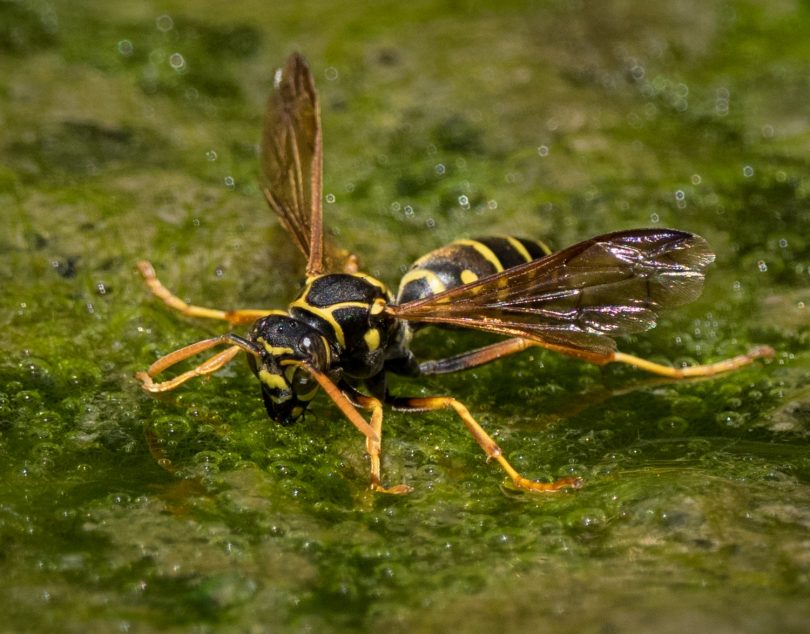
The day after the wasp attack, Evie recovering in TCH. Photo Samara Zeitsch
The devastating consequences of the spread of European Wasps have been sharply brought into focus by a swarm attack on a 7-year-old Braidwood girl while playing at the local recreation ground.
Young Evie Clark suffered around 200 stings leaving her barely conscious.
Evie had been playing with two school friends in the creek area, beside the playing fields while Dad Troy was coaching soccer. She was stung by one and screamed. Her friend turned to see a lot more coming for her.
She was in and out of consciousness as they drove straight to the Braidwood Hospital, where the Newborn & Paediatric Emergency Transport Service in Sydney worked with the local doctor via a video link.
Evie was brought back from the brink at Braidwood before being flown to Canberra Hospital.

Flying into TCH on the Toll Rescue Helicopter.
“The treatment was mainly keeping her hydrated, monitoring vital signs and monitoring blood for signs her organs (particularly kidneys and liver) weren’t coping,” Evie’s mother Samara Zeitsch said.
“Without the hydration, the kidneys would get damaged from the venom.
“There’s no anti-venom, which usually isn’t an issue because you would never get enough venom from a couple of bites.
“Her blood clotting was also affected but again were just monitored until they came down. The initial first aid was adrenaline in the muscle then intravenously,” she said.

Evie back home in Braidwood. Photo: Samara Zeitsch
Evie is now doing well, the swelling has gone, but the itching persists.
European Wasps were first found in Tasmania in 1959, and then near Melbourne in 1977. They are now widespread in Australia.
In spring they come out looking for a sugary feed, and then towards the end of summer start looking for protein to get them through the winter, which is why you often see them on car bumper bars feeding on dead insects.
It is important never to swat a European Wasp, as they put out a pheromone calling the rest of the hive to come and attack. This was the likely scenario for young Evie after stepping on one.
“European wasps appear to have no predators in Australia and have the potential to dominate entire ecosystems,” Braidwood farmer, forester and ecologist Peter Marshall said.
Marshall has spent 10 years researching the feral pests and is part of a network of scientists researching the best control and eradication methods.
“In New Zealand, the wasps have wiped out bird life from the southern beech forests by competing with insectivorous birds and by destroying eggs and chicks in the nests,” he said.
Marshall has experience in the Nelson Lakes area of New Zealand, where wasps scared away most of the tourists.
“With a coordinated approach, 90 per cent of the wasps have gone now from the area,” he said.
“We need people to be vigilant to see where the wasps are going here.”
Extreme caution must be exercised if a European Wasp or a nest is spotted. Residents are urged to report a sighting to their local council or via the eWasp app at the first instance.

“It’s time to recognise that European Wasps are the feral problem of extreme importance,” Marshall said.
Marshall instigated the Facebook page, ‘Wasp Free Town – Braidwood’ in an effort to inform people of the latest science, and to coordinate a town-wide approach to eradicating them.
Asian Paper Wasp problem builds…

Asian Paper Wasp (Polistes chinensis) Photo: Kerri-Lee Harris (Canberra, Feb 2018)
On the Far South Coast, another problem feral is the Asian Paper Wasp (Polistes chinensis).
The introduced species which has recently arrived in the Bega Valley is an invasive pest, but there is a chance to eradicate them if action is taken now.
In order to develop an action plan, Bega Valley Shire Council and other land management groups first need to know how far the species has spread.
The Asian Paper Wasp looks like our local, native paper wasps, but they can be identified by the distinct pattern of stripes and spots. They are well established in Canberra but seem to have only recently arrived in the Bega Valley.
The community is being asked to report any sightings of the Asian Paper Wasp. The best way is to add your sightings directly to NatureMapr.
If you’re not sure of the exact identity of the wasp, that’s fine. Just take a few photos, add the sighting to NatureMapr, and one of the insect experts will check it for you.
You can also contact Andrew Morrison at Bega Valley Shire Council at – [email protected]







